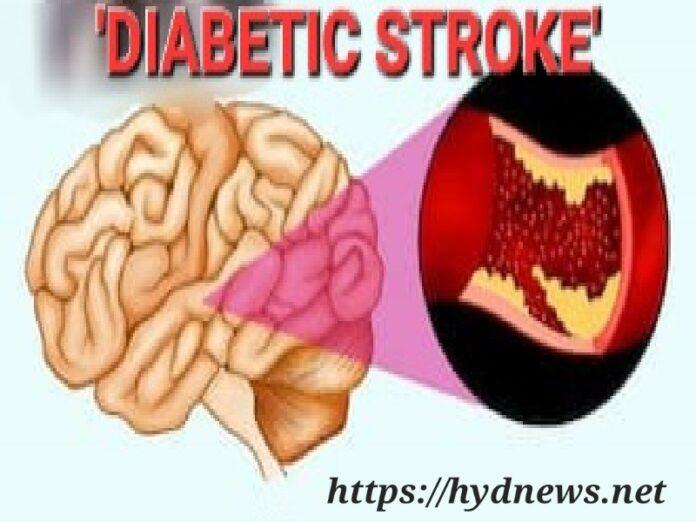Nowadays,a killer disease ‘Diabetic Stroke’ is shaking dagger on long diabetics in Telugu States. Many hospital reported the several cases of this nature coming as emergency cases with hospitalisation. This is a matter of concern as mortality in thesr cases are high compare to cardiac arrest.
Diabetic stroke is a serious condition that occurs when a blood clot blocks an artery in the brain or when a blood vessel in the brain ruptures. This can lead to damage to brain tissue and can be fatal.
Diabetic stroke is on the rise in the Telugu states of Andhra Pradesh and Telangana. This is due to a number of factors, including:
- The increasing prevalence of diabetes in the region
- The growing population of the region
- The changing lifestyle of people in the region
Diabetes is a major risk factor for stroke. People with diabetes are two to four times more likely to have a stroke than people without diabetes. This is because diabetes can damage the blood vessels in the brain, making them more likely to clot or rupture.
The growing population of the Telugu states is also a factor in the rise of diabetic stroke. The population of Andhra Pradesh is expected to reach 45 million by 2025, and the population of Telangana is expected to reach 30 million by 2025. This means that there will be more people at risk of developing diabetes and diabetic stroke.
The changing lifestyle of people in the Telugu states is also a factor in the rise of diabetic stroke. People in the region are eating more unhealthy foods, becoming more sedentary, and smoking more cigarettes. These lifestyle changes can all increase the risk of developing diabetes and diabetic stroke.
There are a number of things that can be done to reduce the risk of diabetic stroke. These include:
- Controlling blood sugar levels
- Controlling blood pressure
- Controlling cholesterol levels
- Quitting smoking
- Losing weight
- Eating a healthy diet
- Exercising regularly
If you have diabetes, it is important to see your doctor regularly for checkups and to discuss your risk of stroke. If you have any of the symptoms of a stroke, such as sudden weakness or numbness on one side of the body, difficulty speaking, or vision problems, it is important to seek medical attention immediately.
Diabetes is a major risk factor for stroke. People with diabetes are two to four times more likely to have a stroke than people without diabetes. This is because diabetes can damage the blood vessels in the brain, making them more likely to clot or rupture.
Diabetic stroke is a type of stroke that occurs in people with diabetes. It is caused by a blockage or rupture of an artery in the brain, which can lead to brain damage or death. Diabetic stroke is a serious condition that can have a devastating impact on a person’s life.
The incidence of diabetic stroke is on the rise in the Telugu states. This is due to a number of factors, including the increasing prevalence of diabetes, the aging population, and the rising rates of obesity and hypertension.
How are these two conditions connected, and what symptoms may one experience when both strike together? Read on to know it all.
Diabetes is a condition marked by a sudden surge in the body’s blood glucose levels. This mainly happens due to the lack of insulin production. Insulin is a hormone secreted by the pancreas and helps convert blood glucose into energy that the body requires to function correctly. Now, due to the lack of insulin production by the pancreas, the sugar levels go for a toss in the blood, giving rise to a condition called high blood sugar, or diabetes.
Uncontrolled blood glucose levels can have a severe impact on the overall health of a person. From triggering heart diseases to causing a brain stroke, diabetes can do a lot to your body than you could ever think. Today, we will understand the connection between brain stroke and uncontrolled blood sugar levels.
Diabetic Stroke: What Is It?
Yes, you read that right, diabetic stroke. People with diabetes have a higher risk of a stroke than those without. The risk of suffering the worst health conditions, or even death is higher with an ischemic stroke, and patients suffering from diabetes have a higher risk of small bleeds in the brain, known as cerebral microbleeds. This worsens the condition inside the brain, leading to a severe brain stroke.
Is high blood sugar levels related to brain stroke?
Yes, the connection, as discussed above is real and happens due to the formation of blood clots inside the brain due to high sugar levels in the blood. Diabetes means you have too much sugar in your blood. This can increase the risk of a stroke because having too much sugar in your blood can severely damage the blood vessels. And added to this, high blood sugar levels can also make blood vessels become stiff.
What happens inside the brain before the stroke?
Diabetes is a well-established risk factor for stroke. It can cause clotting of the blood vessels, thus blocking the blood flow to the brain. This hindrance in the blood flow to the brain can cause cells inside the brain to die within minutes. Another cause is stenosis or narrowing of the artery.
High sugar levels in the blood can cause pathologic changes in blood vessels at various locations inside the brain. This can lead to stroke if cerebral vessels are directly affected. Additionally, experts say that the mortality is higher and post-stroke outcomes are poorer in patients who have suffered a stroke with uncontrolled glucose levels.
Symptoms of A Diabetic Stroke
Recognizing the signs and symptoms of a stroke is a crucial first step to getting help. Therefore, we have jotted down all the signs and symptoms that one who is suffering from diabetes or high blood sugar, can experience before a brain stroke. Below mentioned are some of the common diabetes-related stroke symptoms:
- Trouble talking
- Extreme fatigue
- Dizziness
- Problems with balancing the body
- Sudden and severe headache
- Confusion
- Blurry vision
- Weakness
- Numbness on one side of the body (for example, one side of the face, one arm or one leg).
- Fainting
What blood sugar level can cause a stroke?
Elevated blood glucose is common in the early phase of stroke. The prevalence of hyperglycemia, defined as blood glucose level >6.0 mmol/L (108 mg/dL), has been observed in two-thirds of all ischemic stroke subtypes on admission and in at least 50% in each subtype including lacunar strokes.
What Are The Risk Factors For Diabetic Stroke?
The common risk factors can include:
- Uncontrolled high blood pressure
- High cholesterol
- Sickle cell disease
- Circulation problem
- Atrial fibrillation
- Obesity or overweight
- A family history
Speaking to #Khabarlive, Dr Pratap Rai said, “Many people with high blood sugar levels or diabetes are suffering from obesity and cardiovascular problems. These two health conditions can further increase the risk of a diabetic stroke.”
With early diagnosis and treatment, the chances of recovery from diabetic stroke are good. However, even with treatment, some people may experience long-term effects of a stroke, such as paralysis, difficulty speaking, or memory problems.
If you have diabetes, it is important to take steps to reduce your risk of stroke. By controlling your blood sugar levels and other risk factors, you can help to protect yourself from this serious condition. #hydnews #khabarlive







